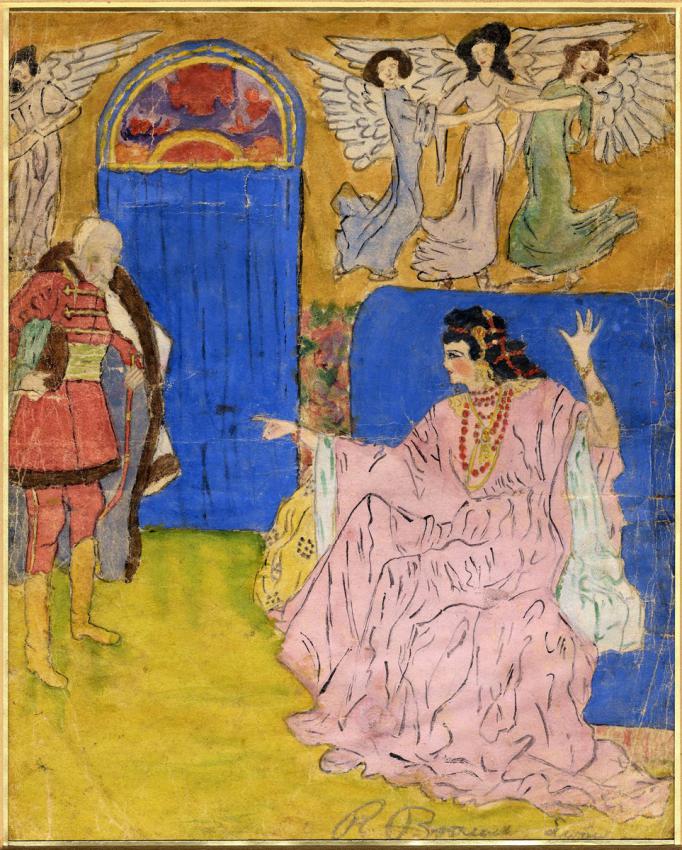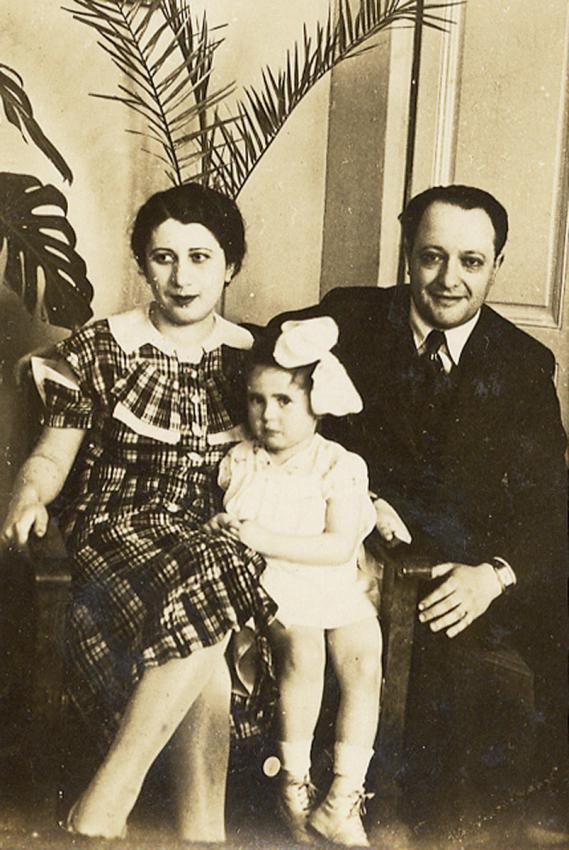
Gouache on paper
Yad Vashem Art Collection



Sunday to Thursday: 09:00-17:00
Fridays and Holiday eves: 09:00-14:00
Yad Vashem is closed on Saturdays and all Jewish Holidays.
Entrance to the Holocaust History Museum is not permitted for children under the age of 10. Babies in strollers or carriers will not be permitted to enter.

Gouache on paper
Yad Vashem Art Collection



"One, I never met my grandmother. Two, my name is Danielle Rina Cohen-Levy. Three, my grandmother’s name was Renata Braun, later Rina Levy. Four, my grandmother died at the age of 38. In 12 years, I will be older than she ever was. Five, she died of breast cancer. That’s why, every year, I’m being screened. Six, for forty years my grandfather kept a secret in his attic. Seven, everything I’m telling you here is the truth."
These were the opening words of Danielle Cohen-Levy’s one-woman show, performed during a ceremony held at Yad Vashem in July to honor her late grandmother, Renata Braun. The artworks created by Braun as a young girl in hiding in Lwów between 1943 and 1944 were donated by her children to the Yad Vashem Art collection. The story behind the artworks came to light almost by accident. Some four years ago, an article in the Israeli daily Haaretz caught the attention of Yehudit Inbar, Director of Yad Vashem’s Museums Division. The article, devoted to contemporary artist Maya Cohen-Levy, mentioned her mother Renata, who had painted as a child during the Holocaust. Inbar, whose field of research deals with the experiences of children and their creativity during the Shoah, contacted Cohen-Levy to learn more about her mother and the drawings she left behind.
During WWII, Renata Braun was hidden in the cellar of the home of a Mrs. Vogel, the widow of a Polish physician, in Lwów. At first, 11-year-old Renata was able to maintain contact with her parents in the ghetto thanks to Vogel, who passed on her letters. However, at the end of May 1943, all contact was lost. Renata’s parents, Dr. Karol and Luzia Braun, did not manage to escape as planned to the "Aryan side." They were probably murdered in the aktion to liquidate the ghetto that began on 1 June 1943.
Renata remained in hiding at Vogel's house until the end of the war. In the long hours in the basement, the young girl found refuge from terror and loneliness in the far reaches of her imagination, through intensive reading and painting. She expressed her longings for her family in portraits of her mother based on photographs she had lovingly kept. She also depicted scenes from well-known Polish books and fairytales.
After liberation, the Jewish community helped Renata reach Kraków. From there, she emigrated to Eretz Israel, where she studied art full time. She married Hassid Levy and the couple had three children. Renata – now Rina – found work as a preschool teacher, but continued painting until she succumbed to cancer at the age of 38.
Seven artworks that Renata had kept with her from the war were given by her husband and children to Yad Vashem in 2010. The gouache paintings and drawings, all on paper and in poor condition, underwent a long process of cleaning and preservation in the conservation laboratories. On the back of one of the works, musical notes, probably hummed by Renata while she was painting, were discovered. Three of the artworks were identified by museum staff as scenes from Pan Tadeusz, the famous Polish epic poem by Adam Mickiewicz, while a fourth was based on a classic artwork by Jan Matejko, a prominent 19th-century Polish artist. Facing the destruction of her universe, Renata held tight to the anchors of literature, art and music she had learned to cherish at home during the brief blissful years prior to the war.
During their visit to Yad Vashem, Renata’s family was thrilled to learn about the research conducted and see the works they had donated displayed in the Holocaust Art Museum. “The artworks hanging here are testimony to a victory over horrific suffering,” said Maya Cohen-Levy, who spoke on behalf of the family. “These innocent works represent a ray of light emerging from that dark place, and give evidence to the boundless power of the human spirit."
The artworks and story of Renata Braun formed part of an exhibition on the dreams and hopes of children during the Holocaust, curated by Yehudit Inbar, presented by Yad Vashem at the UN on International Holocaust Remembrance Day, 27 January 2012.
First published in Yad Vashem Jerusalem magazine, #63, October 2011

Thank you for registering to receive information from Yad Vashem.
You will receive periodic updates regarding recent events, publications and new initiatives.

"The work of Yad Vashem is critical and necessary to remind the world of the consequences of hate"
Paul Daly
#GivingTuesday
Donate to Educate Against Hate


Worldwide antisemitism is on the rise.
At Yad Vashem, we strive to make the world a better place by combating antisemitism through teacher training, international lectures and workshops and online courses.
We need you to partner with us in this vital mission to #EducateAgainstHate
The good news:
The Yad Vashem website had recently undergone a major upgrade!
The less good news:
The page you are looking for has apparently been moved.
We are therefore redirecting you to what we hope will be a useful landing page.
For any questions/clarifications/problems, please contact: webmaster@yadvashem.org.il
Press the X button to continue



